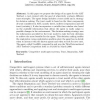1016 search results - page 103 / 204 » Explore or Exploit |
IJCAI
2001
13 years 10 months ago
2001
R-max is a very simple model-based reinforcement learning algorithm which can attain near-optimal average reward in polynomial time. In R-max, the agent always maintains a complet...
ATAL
2010
Springer
13 years 10 months ago
2010
Springer
An important drawback to the popular Belief, Desire, and Intentions (BDI) paradigm is that such systems include no element of learning from experience. In particular, the so-calle...
CAEPIA
2009
Springer
13 years 10 months ago
2009
Springer
In this paper we propose the design of an agent for the ART Testbed, a tool created with the goal of objectively evaluate different trust strategies. The agent design includes a tr...
GECCO
2008
Springer
13 years 10 months ago
2008
Springer
We show how and why using genetic operators that are applied with probabilities that depend on the fitness rank of a genotype or phenotype offers a robust alternative to the Sim...
ALGORITHMICA
2007
13 years 9 months ago
2007
This paper proposes the Protein Ensemble Method (PEM) to model equilibrium fluctuations in proteins where fragments of the protein polypeptide chain can move independently of one ...

